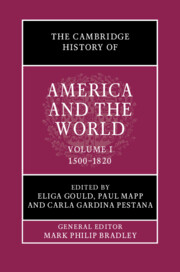Book contents
- The Cambridge History of America and the World
- The Cambridge History of America and the World
- The Cambridge History of America and the World
- Copyright page
- Contents
- Figures
- Maps
- Contributors to Volume I
- General Introduction: What is America and the World?
- Introduction: What Does America and the World “Mean” before 1825?
- Part I Geographies
- Part II People
- Part III Empires
- Part IV Circulation/Connections
- Part V Institutions
- 17 Slavery, Captivity, and the Slave Trade in Colonial North America’s Global Connections
- 18 A Maritime World
- 19 Antislavery in America, 1760–1820: Comparisons, Contours, Contexts
- 20 Women, Gender, Families, and States
- 21 Empires and the Boundaries of Religion
- Part VI Revolutions
- Index
21 - Empires and the Boundaries of Religion
from Part V - Institutions
Published online by Cambridge University Press: 12 November 2021
- The Cambridge History of America and the World
- The Cambridge History of America and the World
- The Cambridge History of America and the World
- Copyright page
- Contents
- Figures
- Maps
- Contributors to Volume I
- General Introduction: What is America and the World?
- Introduction: What Does America and the World “Mean” before 1825?
- Part I Geographies
- Part II People
- Part III Empires
- Part IV Circulation/Connections
- Part V Institutions
- 17 Slavery, Captivity, and the Slave Trade in Colonial North America’s Global Connections
- 18 A Maritime World
- 19 Antislavery in America, 1760–1820: Comparisons, Contours, Contexts
- 20 Women, Gender, Families, and States
- 21 Empires and the Boundaries of Religion
- Part VI Revolutions
- Index
Summary
“Religion” is an expansive idea, but not, to use the words of Jonathan Z. Smith, a “native category.” Smith’s pithy phrase reminds historians not to approach the religious history of contact and colonization as a moment in which European, Indigenous, and African peoples came to confront one another’s religions, because the concept itself – its grouping of ethical systems, origin stories, and beliefs about transcendent truths – was an exclusively European idea. It was an important one, however, because religion functioned for Europeans as an organizing concept in the dynamics of conquest, enslavement, and revolution. They used religion to define the borders between peoples, and those boundaries influenced the shape and tenor of empires. Two religious boundaries warrant particular attention. The first is the border between Christians and non-Christians. This distinction existed primarily for Europeans; it justified expansion across the globe and the conquests that followed. The second border is between Protestants and Catholics, the confessional competition that shaped politics and warfare in the early modern period and also marked the boundaries of civic participation for those in the British Empire.
- Type
- Chapter
- Information
- The Cambridge History of America and the World , pp. 462 - 484Publisher: Cambridge University PressPrint publication year: 2022

